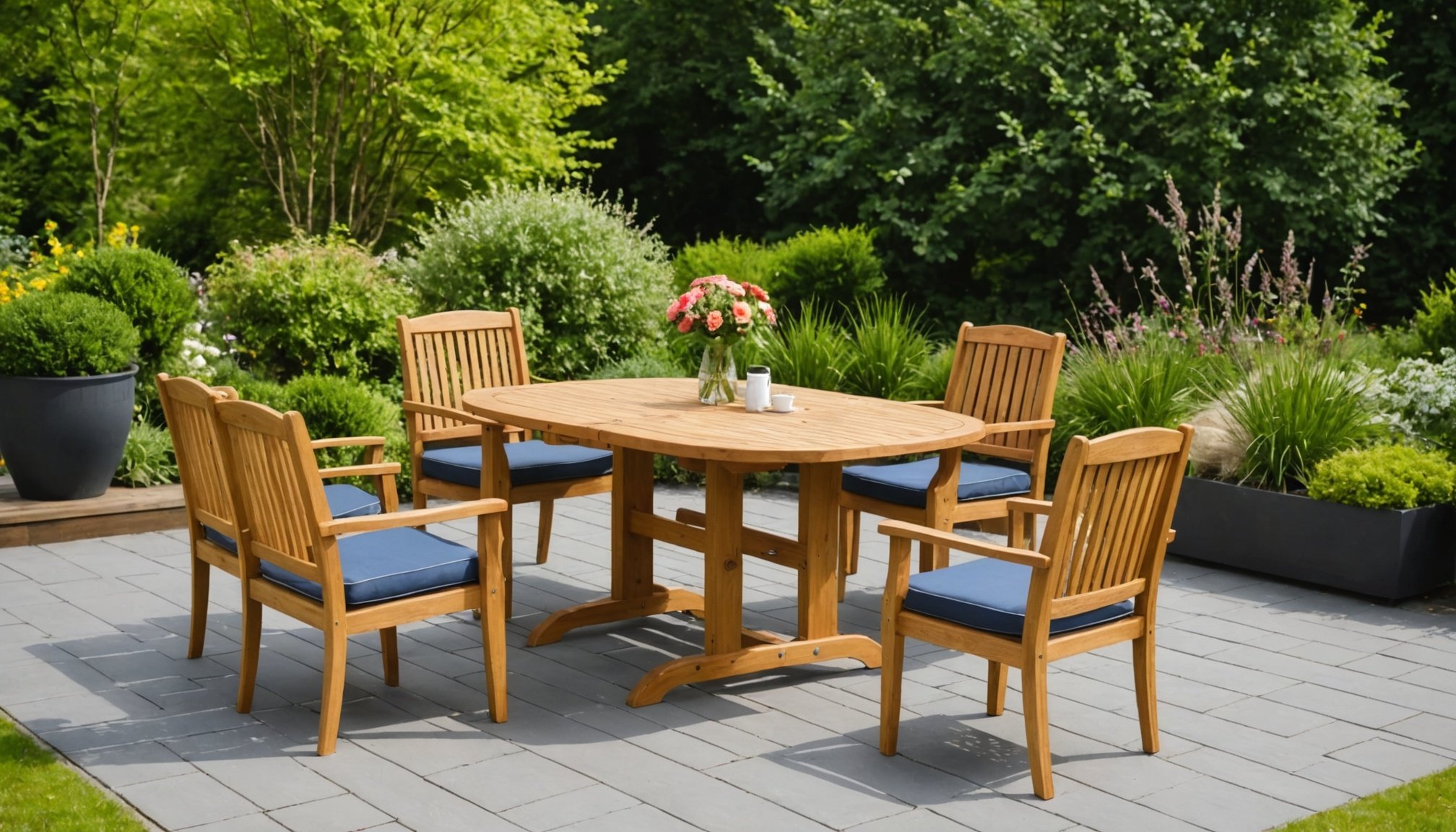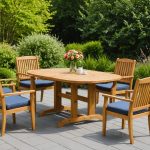Wooden outdoor furniture adds warmth and charm to your garden, but the UK weather can take its toll. Proper preservation is key to maintaining both durability and style. By following a few essential tips, you’ll not only extend the life of your furniture but also keep it looking beautiful season after season. From choosing the right protective coatings to regular maintenance routines, discover practical strategies that will help you enjoy your outdoor space to the fullest.
Understanding the Unique Challenges of UK Weather on Wooden Outdoor Furniture
The UK weather impact on outdoor furniture is a significant consideration for those investing in wooden pieces. With its notoriously unpredictable climate, the UK presents unique challenges that can affect the longevity and appearance of outdoor furniture.
Cela peut vous intéresser : Ultimate Guide to Keeping Your Conservatory Warm This Winter in the UK
The typical UK climate is characterised by frequent rainfall, varying temperatures, and occasional frost, all of which can take a toll on wood. Rain can lead to swelling and warping, while prolonged exposure to the sun may cause fading and cracking. Frost, on the other hand, can exacerbate these issues by causing the wood to become brittle and more susceptible to damage.
Location plays a crucial role in assessing the weather's impact. For example, furniture placed in a shaded area may be more protected from direct sunlight but could be more prone to moisture accumulation, leading to potential rot or mould. Conversely, furniture in a sunny spot may experience less moisture damage but more UV degradation.
A voir aussi : Smart Storage Solutions: Designing a Space-Efficient Kitchen for Your Compact UK Flat
Understanding these factors can help in making informed decisions about the placement and maintenance of wooden outdoor furniture, ensuring it withstands the UK weather with minimal deterioration.
Essential Cleaning Methods for Wooden Outdoor Furniture
To maintain the beauty and durability of wooden outdoor furniture, regular cleaning is crucial. The choice of cleaning products can significantly impact the longevity of your furniture. Mild soap solutions and specialised wood cleaners are recommended, as they effectively remove dirt without stripping the wood's natural oils. Avoid harsh chemicals that can damage the wood's finish.
Step-by-Step Cleaning Process
- Dust and Debris Removal: Start by brushing off loose dirt and debris with a soft brush or cloth.
- Apply Cleaning Solution: Mix a small amount of mild soap with warm water. Gently scrub the surface with a soft brush, following the grain of the wood to prevent scratches.
- Rinse Thoroughly: Use a garden hose to rinse off the soap, ensuring no residue is left that could attract dirt.
- Drying: Allow the furniture to air dry completely in a shaded area to avoid sun damage.
Frequency of Cleaning
The frequency of cleaning depends on the furniture's usage and exposure. For pieces exposed to harsh weather or heavy use, a monthly clean is advisable. For less exposed furniture, quarterly cleaning is sufficient. Regular maintenance helps preserve the wood's appearance and integrity.
Protective Treatments for Longevity
To ensure the longevity of wooden outdoor furniture, employing effective wood protection treatments is essential. These treatments not only enhance the furniture's appearance but also shield it from the harsh UK weather.
Types of Protective Finishes
There are several types of finishes to consider:
- Oils: Penetrate the wood, enriching its natural colour while providing moisture resistance. They require regular reapplication, typically every 6 to 12 months.
- Stains: Offer a range of colours and add a layer of protection against UV rays. They are ideal for enhancing the wood's grain and should be reapplied every couple of years.
- Sealants: Form a protective barrier on the wood's surface, offering robust protection against water and UV damage. These are best for areas with high moisture exposure and need reapplication every 1 to 3 years.
Application Methods and Frequency
The application method varies with each treatment. Oils are best applied with a cloth, stains with a brush, and sealants with a sprayer or brush. Consistent maintenance is crucial for optimal protection.
Benefits of UV Protection and Waterproofing
Incorporating UV protection and waterproofing in your treatments helps prevent fading and swelling, ensuring your furniture remains beautiful and durable over time.
Seasonal Care for Wooden Outdoor Furniture
Seasonal maintenance is vital to preserve the condition of wooden outdoor furniture. Each season presents distinct challenges and opportunities for care.
Preparing Furniture for Winter Storage
Winter can be harsh on wood, so preparation is crucial. Start by cleaning the furniture thoroughly to remove dirt and debris. Apply a protective sealant to shield against moisture and frost. If possible, store furniture indoors or use breathable covers to prevent mould and mildew.
Spring Cleaning and Maintenance Checklist
Spring is the perfect time to rejuvenate your furniture. Begin with a deep clean using a mild soap solution to remove any winter residue. Inspect for damage such as cracks or loose joints, and perform necessary repairs. Reapply oils or stains to restore the wood's natural beauty and protection.
Summer Care Tips to Enhance Durability
In summer, the focus is on protecting against UV rays and heat. Regularly clean the furniture to prevent dirt build-up. Apply UV-protective finishes to minimise fading and cracking. Ensure the furniture is placed in a shaded area or use umbrellas to provide additional protection from direct sunlight.
By following these seasonal maintenance tips, you can ensure your wooden outdoor furniture remains in excellent condition year-round.
Choosing the Right Wood for Outdoor Furniture
Selecting the best wood types for outdoor furniture is crucial for ensuring longevity and aesthetics. Different wood species offer varying levels of durability, maintenance needs, and visual appeal.
Comparison of Wood Species
- Teak: Renowned for its natural oils, teak is highly resistant to water and pests, making it an excellent choice for outdoor use. It ages beautifully, developing a silver-grey patina over time.
- Cedar: Lightweight and naturally resistant to decay and insects, cedar is ideal for those seeking a rustic look. It requires regular maintenance to retain its colour.
- Eucalyptus: A more affordable option, eucalyptus offers durability and a rich, warm hue. It necessitates periodic oiling to maintain its moisture resistance.
- Acacia: Known for its strength and resistance to wear, acacia is a versatile choice. It requires occasional sealing to prevent cracking.
Aesthetics and Maintenance Considerations
When choosing wood, consider the desired aesthetic and the maintenance you are willing to undertake. Woods like teak and cedar offer distinct looks and require different care levels.
Sourcing Quality Wood
For sourcing quality wood products, opt for suppliers who provide sustainably harvested materials. This ensures not only environmental responsibility but also the longevity and quality of your outdoor furniture.
Enhancing Aesthetic Appeal While Ensuring Durability
When it comes to stylish outdoor furniture, balancing aesthetics with durability is key. Incorporating design elements that enhance longevity is essential. Opt for furniture with reinforced joints and weather-resistant finishes to withstand the elements.
Design Elements for Longevity
Choose pieces crafted from robust materials like teak or acacia, known for their natural resilience. Look for designs that incorporate slatted surfaces, which allow for water drainage, reducing moisture damage.
Colour and Finish Choices
Selecting the right colour and finish is crucial for both style and protection. Natural wood tones can be accentuated with UV-resistant stains, which not only enhance the wood’s beauty but also protect it from sun damage. For a modern look, consider painted finishes with weatherproof coatings to prevent peeling and fading.
Accessorizing Without Compromise
Accessorizing your outdoor space can elevate its aesthetic appeal. Use cushions and throws made from fade-resistant fabrics to add comfort and style. Ensure that accessories are easily removable, allowing for protection during adverse weather conditions. By choosing accessories wisely, you can enhance the look of your outdoor furniture without compromising its durability.
Product Recommendations for Maintenance
Maintaining wooden outdoor furniture requires the right products and tools to ensure its longevity and appeal. Choosing the best products for outdoor wood care is crucial for effective maintenance.
Top-Rated Cleaning Products and Tools
For cleaning, opt for mild soap solutions specifically designed for wood. Products like Murphy’s Oil Soap or Howard Clean-A-Finish are popular choices. Pair these with a soft-bristle brush to gently remove dirt without damaging the wood's surface. A microfiber cloth is also useful for wiping away excess moisture post-cleaning.
Recommended Protective Treatments and Finishes
To protect your furniture, consider using high-quality oils and sealants. Tung oil and Danish oil are excellent for nourishing the wood and enhancing its natural grain. For added protection, a sealant like Thompson’s WaterSeal can provide a robust barrier against moisture and UV damage.
Tools for Effective Seasonal Maintenance
Seasonal care involves tools such as a power washer for deep cleaning, especially after winter storage. A paintbrush or sprayer is essential for applying protective finishes evenly. Additionally, invest in breathable furniture covers to shield your pieces from the elements during off-seasons.
Recognizing Signs of Damage and Repair
Understanding when wooden furniture repair is necessary can save time and money. Outdoor wooden furniture is prone to wear due to environmental factors. Identifying common signs of damage early helps maintain its integrity and appearance.
Common Signs of Wear and Damage
Look for cracks, warping, and discolouration. These are typical indicators that your furniture needs attention. Cracks can develop from moisture fluctuations, while warping often results from prolonged exposure to rain or sun. Discolouration may indicate UV damage or mould growth.
Quick Fixes for Minor Issues
For minor problems, simple solutions can be effective. Use wood filler for small cracks and sand the area smooth once it dries. Warped sections might be corrected by applying moisture and weight to reshape the wood. Regularly applying oils or sealants can prevent further damage by reinforcing the wood’s natural defences.
When to Seek Professional Repair Services
If damage is extensive, such as deep structural cracks or severe warping, professional repair services are advised. Experts can assess the severity and provide solutions that ensure the longevity of your furniture. Investing in professional help can often restore pieces to their original condition, preserving their beauty and functionality.
Creating a Maintenance Schedule
A well-structured outdoor furniture maintenance plan is crucial for preserving the beauty and functionality of your wooden pieces. Regular upkeep not only extends the furniture's lifespan but also enhances its aesthetic appeal.
Importance of a Structured Maintenance Routine
Establishing a consistent maintenance routine ensures that your furniture receives the care it needs throughout the year. By adhering to a schedule, you can prevent minor issues from escalating into costly repairs. This proactive approach helps maintain the wood's integrity and appearance.
Suggested Timeline for Cleaning and Treatments
To keep your furniture in top condition, follow a seasonal schedule. Spring is ideal for deep cleaning and applying protective oils or stains. Summer requires regular cleaning and UV protection applications. In autumn, focus on sealing the wood to prepare for winter. During winter, store or cover furniture to shield it from harsh weather.
Utilizing Checklists for Effective Upkeep
Checklists are valuable tools in an outdoor furniture maintenance plan. They ensure no step is overlooked, from cleaning to applying treatments. Include tasks like inspecting for damage, reapplying finishes, and cleaning accessories. By following a checklist, you can systematically address each aspect of maintenance, ensuring comprehensive care.
Engaging Visuals and Resources
Incorporating visuals into your outdoor furniture maintenance resources can significantly enhance your understanding and execution of maintenance tasks. Visual aids like diagrams, step-by-step photo guides, and instructional videos provide clear demonstrations of techniques, making complex processes more accessible.
Suggested Online Resources and Guides
Online platforms offer a wealth of resources for maintaining wooden outdoor furniture. Websites dedicated to home improvement often feature detailed guides and tutorials. Look for resources that include both text and visuals to cater to different learning styles. Additionally, many manufacturers provide specific care instructions and maintenance tips on their websites, tailored to their products.
Benefits of Community Forums and Expert Advice
Community forums and expert advice are invaluable outdoor furniture maintenance resources. Engaging with online communities allows you to share experiences and solutions with other furniture enthusiasts. These forums often feature discussions on the latest maintenance techniques and product recommendations. Moreover, seeking expert advice ensures that you receive accurate and reliable information tailored to your specific needs. Experts can offer insights into advanced maintenance strategies and troubleshoot any issues you might encounter, ensuring your furniture remains in pristine condition.












